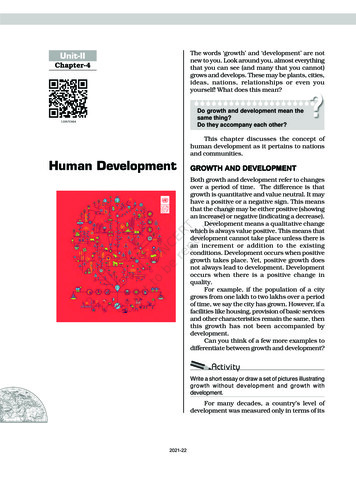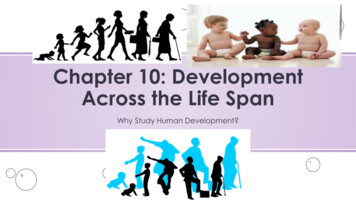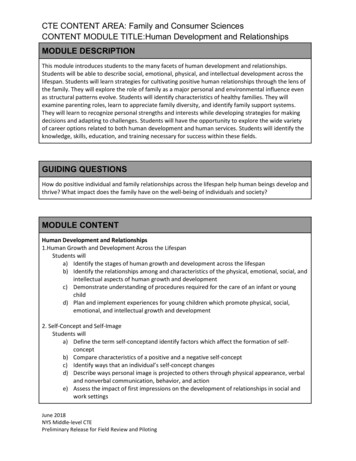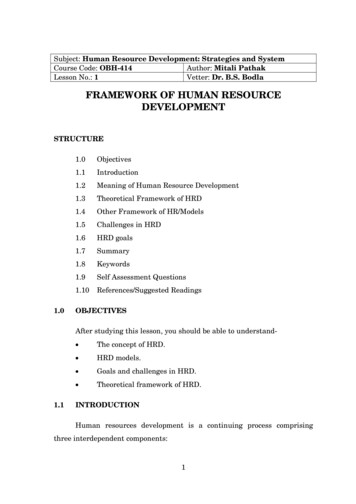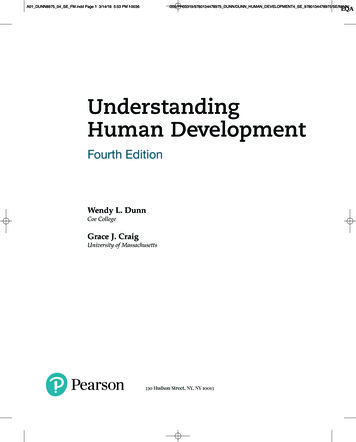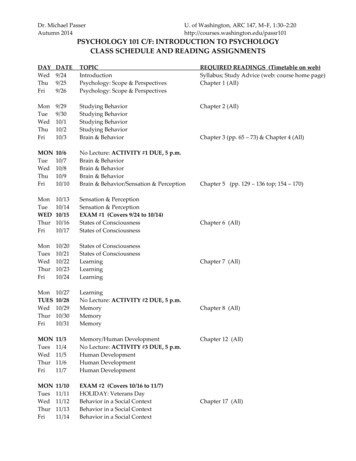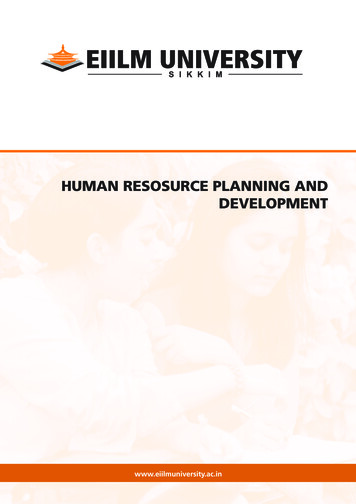
Transcription
HUMAN RESOSURCE PLANNING ANDDEVELOPMENTwww.eiilmuniversity.ac.in
Subject: HUMAN RESOSURCE PLANNING AND DEVELOPMENTCredits: 4SYLLABUSMacro Level manpower Planning and Labour market Analysis - Organisational Human Resource Planning -Stock Taking -- Work Force Flow mapping -- Age and Grade Distribution mapping.Models and Techniques of manpower demand and supply forecasting-- Behavioural Factors in HRD -- WastageAnalysis ñ Retention -- Redeployment and Exit Strategies.Career Management, Career Planning and Career Development, Performance Planning -- Potentials Appraisal -HRD Climate.Human Resource Information System -- Human Resource Accounting.Suggested Readings:1. Strategic HRM by Mabey and Salama2. Development Human Resources by Mabey and Thompson3. Human Resource Information System: Development and Application by Kavanagh M.J
HUMAN RESOURCE PLANNING AND DEVELOPMENTHUMAN RESOURCE PLANNING AND DEVELOPMENTCOURSE OVERVIEWFrom earliest recorded times, groups of people have beenrelate these to the professional standards. It covers the practicalorganised to work together towards planned goals. Considerapplication of personnel theory.the management skill required by the ancient Chinese to buildAs every one of you have an interest in Human Resources as athe Great Wall of China, Egyptians to build their Pyramids, thecareer, everyone is likely to be called upon at some time to dealmanagement skills of the Mesopotanians to irrigate the landwith “people issues”. This course will provide you with helpfuland wall the cities. All these manual construction required largeinformation and insights after all every manager is a Humanamount of h an efforts. It was only because of the efficiencyResource Manager! !and effectiveness of people that these feats were achieved. Theimportance of humans cannot be undermined.Using a seminar-discussion format, we will explore currentreadings and other sources of informa-tion about the changingAlthough the word and concept is of fairly recent origin, thenature of Human Resource Development and, more broadly,search for an optimum application of human resources tothe world of work in general. A list of topics has been includedcomplete projects has been around for a long time. Humanbut I would like our explorations to be somewhat flexible soResource Manage-ment has been an ever-evolving field.that we can consider new issues as they arise.The rate of change facing organisations has never been greaterAdditionally, you may have some issues that you would like toand organisations must absorb and manage change at a muchexplore in further depth and I would like to maintain somefaster rate than in the past. In order to implement a successfulflexibility in the course to allow us to explore issues in whichbusiness strategy to face this challenge organisations, large oryou are inter-ested. In general, this course will have a strongsmall, must ensure that they have the right people capable ofpractical orientation. Most of the readings will be fromdelivering the strategy.publications directed toward practitioner (versus academic)As organisations vary in size, aims, functions, complexity,audiences. In addition, the course’s practical orientation includesconstruction, the physical nature of their product and appeal asan assignment in which you will initiate and maintain an on-lineemployers, so do the contribution of human resource manage-mentoring relationship with a corporate manager.ment. But in most the ultimate aim of the function is to “The Course Objectives are as follows:ensure that at all times the business is correctly staffed by the1. A familiarity with major sources of information and opinionrelated to management and in particular Human ResourcePlanning and Development .right number of people with the skills relevant to the businessneed”This module Human Resource Planning and Development isdesigned to consider the theory and role of human resourceplanning and development in organisations, and link it topolicies and practices required in organisations for effectivepeople management. The module aims to develop knowledgeand skill in a range of HRD activities in organisations and to2. A basic knowledge of current trends, practices, issues andchanges in Human Resource Planning and Developmentprac-tices.3. An ability to learn effective methods and techniques ofRecruitment and Selection.4. Further developmental of your oral and written skills andthe ability to discuss all the issues of Human ResourceManagement.i
HUMAN RESOURCE PLANNING AND DEVELOPMENT5. Enhanced skills and confidence in identifying/interactingwith mentors and building networks of support inorganizations.6. A deeper understanding of your own values, beliefs, andinterests as they relate to alternative roles, career options andenvironmental in the dynamic work world.My ExpectationsOn completing the course you will have an increased understanding/appreciation of the Human Resource Planning andDevelopment (HRP& D) - functions, its role, concepts,principles and challenges.Everyone will participate in class discussion/activities- intrinsically this implies you will be in class both in body and spiritThere will be a demonstrated respect for the diversity of othersWe will respect the time we spend together by starting class ontime.You will own or have regular access to the text, as you will beexpected to read assigned chap-ters for class discussion andtesting.If you are experiencing difficulty with me, the course, thematerial or your grades, please let me know quickly either via email or arrange to meet with me prior to class.We will have some fun!This course explores the key areas in human resource Planningand Development. It includes human resource planning, HRDInstruments and intervention- Job Analysis and Design,Recruitment and Selection, Training and Development,Performance Management, Compensation, Key issues in HRD.Through a combination of cases, readings, lectures, discussionsetc., the class sessions will engage students in developing andapplying new and newer concepts, tools, models and frameworks that incorporate these dimensions in a competitivemanner.ii
HUMAN RESOURCE PLANNING AND DEVELOPMENTHUMAN RESOURCE PLANNING ANDDEVELOPMENTCONTENT.Lesson No.TopicLesson 1human Resource Planning: Overview-Nature and Need1Lesson 2Human Resource Planning: HRP and Corporate Objectives5Lesson 3Human Resource Planning: Process, Methods and Techniques10Lesson 4Human Resource Planning: Tools and Techniques16Lesson 5Human Resource Planning: HRP and Corporate Objectives21Lesson 6Relationship Between HRM, HRP and HRD28Lesson 7HRD-Concept, Nature & Need for HRD31Lesson 8Evolution of Human Resource Development37Lesson 9Functions of Human Resource Development40Lesson 10Challenges to Human Resource Development Professional45Lesson 11Approaches to HRD48Lesson 12Planning and Organising of Human Resource Development52Lesson 13HRD: The Indian Experience58Lesson 14HRD in Indian Industry63Lesson 15Future of HRD70Lesson 16HRD influence on Employee Behaviour73Lesspn 17HRD influence on Employee Behaviour-Motivation80Lesson 18Job Analysis and Design89Lesson 19Job Analysis-Process and Techniques94Lesson 20Recruitment and selection99Lesson 21Evaluation of Recruitment and Selection process106Lesson 22Orientation and Placement113Lesson 23Global Recruitment-Techno Application116Lesson 24Performance Management120Lesson 25Performance Counseling and Job Evaluation127Lesson 26Potential Appraisal133Lesson 27The relevance of American theories of motivationwith regard to compensation and rewardviPage No.135
LESSON 1:HUMAN RESOURCE PLANNING:OVERVIEW-NATURE AND NEEDThe definition of Human Resource PlanningFeatures of HRPNeed/Importance of HRP“ Plan ahead: it wasn’t raining when Noah built the ark.”- Richard CushingDear future managers, now you all are going to becomedynamic managers in the areas of Human Resources Management. Let us discuss, by recollecting, what we have studied inthe 2nd semester in HRM. HRM and other papers must havetaught you how important it is to Plan, Organize, Staffing etc.and therefore for that plan in advance to remain ahead inbusiness. That’s the secret of success in today’s world!!Now, as each one of know that how important the HumanResource Planning.In lieu with that, we will discuss an overview of humanresources planning starting with:subsystem is not performing to the benchmark, in other words,it is declining, it may need to plan a reduction or redeploys itsexisting labor force.On the other hand, if it is growing or diversifying, it mightneed to find and tap into a source of suitably skilled labor (forexample: GE, the pioneers in BPO industry went for a largescale recruitment while setting up office here in India.).That is why; we need to plan in advance even for procuringhuman resources, which in contrast to a general myth are notabundant!! Thus, in the same line, we propose that organization can achieve its goals effective through effective contingenciesof all the HR functions; for example, the structure of anorganization and the design of the job within it affect anorganization’s ability to achieve only through the efforts ofpeople. It is essential therefore, those jobs within the organization be staffed with the personnel who are qualified to performthem. Meeting these staffing needs requires effective planningfor human resources What it is exactly,Lets discuss definitions of HRP as given by different experts: Why is it so important, How it is related to the macro: corporate planning, strategyand objectives, How do you go about it i.e. HUMAN RESOURCEPLANNING PROCESS,Vetter opines that it is the process by which managementdetermines how the organization should move from itsmanpower position to its desired manpower position to carryout integrated plan of the organization. What are the environmental factors to be taken care ofwhile planning? Problems you might counter while doing this process, andfinally What is the latest in HRP (HRP? yes! HRP. It is short forhuman resources planning! You might come acrossmanpower planning in some books that is how it used tobe referred to as earlier!!! )Today’s lesson revolves around the concept of planning forhuman resources that the organization might need in the futurefor the pursuit of its objective.Human resource planning is the process of anticipating andcarrying out the movement of people into, within, and out ofthe organization. Human resources planning is done to achievethe optimum use of human resources and to have the correctnumber and types of employees needed to meet organizationalgoals.Thus, it is a double-edged weapon. If used properly, it leadsnot only to proper utilization, but also reduces excessive laborturnover and high absenteeism, and improves productivity.It can also be defined as the task of assessing and anticipatingthe skill, knowledge and labor time requirements of theorganization, and initiating action to fulfill or ‘source” thoserequirements. Thus, if the organization as a whole or one of itsAccording to Geisler, “Manpower planning is the process –including forecasting, developing and controlling by which afirm ensures that it has The right number of people, The right kind of people, At the right places, At the right time, doing work for which they areeconomically most useful”.Features of HRPWickstrom very beautifully summarizes the features of HRP,viz., Forecasting future manpower requirements, where weuse mathematical projections you might have studied in‘business economics’ and ‘quantitative techniques’ paper,to project trends in the economic environment anddevelopment of the industry. Can you remember one suchapplication? Making an inventory of present manpower resourcesand assessing the extent to which these resources areemployed optimally. Procuring competent personnelrequires positive recruitment efforts and the developmentof a variety of recruitment sources. These sources mustconsider not only the nature and conditions of the externallabor market, but also the presence of qualified personnel1HUMAN RESOURCES PLANNING & DEVELOPMENTLearning ObjectivesUNIT IHUMAN RESOURCE PLANNING:RELATIONSHIPCHAPTER 1: HUMAN RESOURCE PLANNING
HUMAN RESOURCES PLANNING & DEVELOPMENTwho are available to fill vacancies through internalpromotions or transfers.Keep in mind the recruitment activities is integrated withdiversity and equal employment opportunity initiatives.Staffing needs must be anticipated sufficiently in advance topermit the recruitment and development of fully qualifiedpersonnel. Anticipating manpower problems by projectingpresent resources into the future and comparing themwith the forecast of requirements to determine theiradequacy, both quantitatively and qualitatively; and Planning the necessary programmes of requirement,selection, training, development, utilization, transfer,promotion, motivation and compensation to ensure thatfuture manpower requirements are properly met. Ensures optimum use of man (woman, too nowadays?)power and capitalize on the strength of HR. Theorganization can have a reservoir of talent at any point oftime. People skills are readily available to carry out theassigned tasks, if the information is collected and arrangedbeforehand. Forecast future requirements (this is done by keeping trackof the employee turnover.) and provides control measuresabout availability of HR labor time. If, for example theorganization wants to expand its scale of operations, it cango ahead easily. Advance planning ensures a continuoussupply of people with requisite skills who can handlechallenging jobs easily. Help determine recruitment/induction levels. Let meexplain this with an example: you as a manager want todetermine what kind of induction the organization willrequire at such an such date. If you have a ready HR plan,you will have fairly good idea what kind of people arebeing recruited and at what position. Thus you cansuccessfully plan your induction level. To anticipate redundancies/surpluses/obsolescence.Remember Geisler and Wickstrom’s definition? To determine training levels and works as a foundation formanagement development programmes Know the cost of manpower if there is a new project isbeing taken up, example: in cases of expansions or a newfactory, one would naturally requires more humanresources, hence a budgetary allocation can be made inadvance for this upcoming corporate strategic move.So what do you surmise (figure out) the salient features ofHRP from the various definitions?I think:1.It’s a systematic approach. Why? ‘cause it ensures acontinuous and proper staffing. It avoids or checks onoccupational imbalances (shortage or surplus) occurring inany of the department of the organization.2.There is a visible continuity in the process. Very true!! Seethe Wickstrom definition.3.There is a certain degree of flexibility. That is, it is subjectto modifications according to needs of the organization orthe changing circumstances. Manpower plans can be doneat micro or the macro levels 3depending upon variousenvironmental factors.(Dear student, at this point I implore you to keep in touch withthe subjects studied earlier to understand the coming courses!Remember, we discussed the forces of change in your OBcourse?)Thus, we can summarize that -Planning facilitates preparation of an appropriate manpowerbudget for each department or division. This, in turn, helps incontrolling manpower costs by avoiding shortages/excesses inmanpower supply. Assist in productivity bargaining. For example, if a firm isgoing fully automated, it can negotiate for lesser workers asrequired for the same amount of the job by using themanpower predictions regarding the same. It can offerhigher incentives (VRS) to smoothen the process ofvoluntary layoffs. Help assess accommodation requirements (? - You mustbe wondering how that can be related to HRP? A goodHRP can assist in solving many problems of the firm,from day to day ones to very strategic ones, too.) forexample: an organization decides to establish itsproduction center in a remote area, an accurate HR plan canhelp it to decide how many people will be required there,and thus start the process of establishing a township forthem in advance. The physical facilities such as canteen,school, medical help, etc., can also be planned in advance. Management decisions. Now!! Lets see how this canhappen. Example, suppose the question is to outsource anactivity or not? An HR manager knows what is thedistribution of workflow, and whether the presentavailable staff can accomplish these. If it is realized there isno one available for the job in question, and training cost iscoming out to be more or in some cases the skill is not“ HRP is a kind of risk management. It involves realisticallyappraising the present and anticipating the future (as far aspossible) in order to get the right people into right jobs at theright time”. (Reiterating the view of Geisler).Why HR Planning?You know the answer!You all must have understood the importance of planning ingeneral. In designing an environment for the effective performance of individuals working together in groups, a manager’smost essential task is to see that everyone understands thegroups purposes and objective and its methods of attainingthem. If group effort is to be effective, people must know whatthey are expected to accomplish. This is the purpose ofplanning! It is the most basic of the managerial functions(refurbish the text on POSDCoRB!). It bridges the gap fromwhere we are to where we want to be. It makes it possible forthings to happen which would otherwise not happen.Thus, in the context of Human Resources, planning is a must‘cause (here I can enumerate many! But, I expect you come upwith explanatory example for each. Right?)2
In addition, HRP (as already pointed out) prepares people forfuture challenges. The stars can be picked, mentored and keptready for leading positions in future. All MNCs have suchpolicies and programmes (Wipro InfoTech has a leadershipdevelopment programmes), where a “hot list” of promisingcandidate are assessed and assisted continuously for futuremanagement positions. This selection is possible only througha thorough HR plan.An organization may incur several intangible costs as a result ofinadequate HRP or, for that matter, the lack of HRP. Forexample, inadequate HRP can cause vacancies to remain unfilled.The resulting loss in efficiency can be costly, particularly whenthe lead-time is required to train replacements. Situations alsomay occur in which employees are laid off in one departmentwhile applicants are hired for similar jobs in another department. This may cause over hiring and result in the need to layoff those employees to make effective plans for career orpersonal development. As a result, some of the more competent and ambitious ones may seek other employment wherethey feel they will have better career opportunities.Reason for current interest and importance in HRP?You all know the challenges the business is facing due toturbulent and hostile environmental forces (e.g. technology,social, economic and political upheaval) impinging on singleone of them.An excerpt from a statistical report will clarify my point more.“As per the results of the National Sample Survey conducted in1999-2000, total work force as on 1.1.2000, as per Usual Statusapproach (considering both principal and subsidiary activities)was of the order of 401 million. About 7 % of the total workforce is employed in the formal or organised sector (all publicsector establishments and all non-agricultural establishments inprivate sector with 10 or more workers) while remaining 93%work in the informal or unorganised sector. The size of theOrganised Sector employment is estimated through theEmployment Market Information Programme of DGE&T,Ministry of Labour. The capacity of the organised sector toabsorb additional accretion to the labour force, taking intoaccount the current accent on modernisation and automation, islimited.In other words, an overwhelming proportion of the increase inthe labour force will have to be adjusted in the unorganisedsector. About 373 million workers are placed today inunorganised/informal sector in India; agriculture workersaccount for the majority of this work force.Total Labour Force as on 1.1.2000410 millionTotal employed labour force401 millionas on 1.1.2000Growth of labour force1.10 % p.a.during 1994-2000Growth of employment1.05 % p.a.(1994-2000)Fully unemployed as on 1.1.20009 millionHUMAN RESOURCES PLANNING & DEVELOPMENTgoing to be of much use, then such activities can besubcontracted or outsourced. Right? Is it clear?About 41 million jobs seekers (all of them not necessarilyunemployed) are registered with the 938 Employment Exchanges located throughout the country.72% of the job-seekers registered with the EmploymentExchanges are less than 30years of age.Educated (X standard and above) job seekers constitute about69% of the total job seekers registered with the employmentexchanges.(contd)A few important conclusions which emerge from the abovereport are: Limited demand for unskilled and less skilled labour. Increase in demand for skilled labour on account oftechnological development and up gradation and changesin the organisation of work Problems in maintaining the continued employability oflabour force remember this!Demand for multi skilling. Some of the important strategiesrecommended in the World Employment Report are:- TimelyInvestment in skill development and training at enhanced level.(Can you link this to an organisation’s or an industry’s HRplans?) Enhancement of education and skill level of workers Responsive training system. Need for effective partnership of all stakeholders. Take thisinto account too!!In addition, decline in the employment growth in the organizedsector and its shrinking size in absolute terms, liberalizationinduced restructuring exercises by the firms, in both public andprivate sector, and their introduction of so-called innovations,like Total Quality Management, Just-in-Time manufacturing,production flexibilities etc., resulting into casulisation ofworkforce, and the growth of poor quality employment in theunorganized sector, have posed unprecedented challenges to theIndian businesses.(point to ponder: what does an organizationdo in this case, if it is going to need certain class of labor in nearfuture?)Excerpts taken from:Now you see, what the industry might be facing? Thesedramatic shifts in the composition of the labor force will requirethat managers be more involved in HRP, since such changeaffect not only employee recruitment but methods of employeeselection, training, compensation, and motivation.Although planning has always been an essential process ofmanagement, increased emphasis on HRP becomes especiallycritical when organizations considers mergers, relocation ofplants, downsizing, or the closing of operating facilities (whichyou all keep reading, is the character of the modern times).Major reasons for the present emphasis on manpowerplanning include: Employment-Unemployment Situation: Though fromthe above excerpt we can construe that in general thenumber of educated unemployed is on the rise, there is3
HUMAN RESOURCES PLANNING & DEVELOPMENTmanagement concept which all emphasize the planning andhaving common and transparent personnel records.acute shortage for a variety of skills. This emphasizes theneed for more effective recruitment and retaining people. Technological Changes: The myriad changes inproduction technologies, marketing methods andmanagement techniques have been extensive and rapid(e.g. introduction of HRIS). Their effect has beenprofound on job contents and job contexts. These changescause problems relating to redundancies, retraining andredeployment. All these suggest the need to planmanpower needs intensively and systematically.Organisational Changes: In the turbulent environmentmarked by cyclical fluctuations and discontinuities, thenature and pace of changes in organizational environment,activities and structures affect manpower requirements andrequire strategic considerations. Demographic Changes: The changing profile of the workforce in terms of age, gender participation, literacy, technicalinputs and social background have implications formanpower planning. The workforce is more diverse thanever before. And the trend shows it is going to be on therise even more!! Skill Shortages: Unemployment does not mean that thelabor market is a buyer’s market. Organizations have ingeneral become complex and thus, in turn require morespecialist skills that are rare and scarce. The result is moredependency on the professionals. Thus, problems mayarise when such people if they are employees decide toleave or switch to more lucrative employment or if they arefreelancers decide to shift their business somewhere else.Please note that these are example of implications of whatis most happening in the business world today. Governmental Influences: Government control andchanges in legislation with regard to affirmative action fordisadvantaged groups, working conditions and hours ofwork, restrictions on women and child employment, casualand contract labor, etc. have stimulated the organizationsto become involved in systematic manpower planning. Legislative Controls: The days of ‘hire and fire’ policiesare gone. Now legislation makes it difficult to reduce thesize of an organization quickly and cheaply, especially in thepresence of strong politicalised trade union scenario inIndia. It is easy to increase but difficult to shed the fat interms of the numbers employed because of recent changesin labor law relating to lay-offs and closures. Thoseresponsible for managing manpower must look far aheadand thus attempt to foresee manpower problems. . 4Impact of Pressure Groups: Pressure groups such asunions, politicians and NGO’s displaced, from land bylocation of giant enterprises have been raising contradictorypressures on enterprise management such as internalrecruitment and promotions, preference to employees’children, displaced persons, sons of the soil etc. rememberthe ASSAM TEA case!!!!!Systems Concept: The spread of systems thinking, theadvent of the PC’s and the upsurge of people Lead Time: The long lead-time is necessary in the selectionprocess and for training and development of the employeeto handle new knowledge and skills successfully.Thus, HRP is all the more imperative. One needs to thinkstrategically, to be ahead of others in acquiring human resources.Hence we can now easily come to a conclusion on why HRP isnecessary? An attempt to look beyond the present and shortterm future, and to prepare for contingencies, is increasinglyimportant. Some manifestations of this are outlined below. Jobs often require experience and skills that cannot easily bebought in the market place, and the more complex theorganisation, the more difficult it will be to supply orreplace highly specialized staff quickly. It takes time to trainand develop technical or specialist personnel (say, an airlinepilot or computer programmer), so there will be a leadtime to fill any vacancy. The need will be have to beanticipated in time to initiate the required developmentprogrammes. Employment protection legislation and generalexpectations of ‘social responsibility’ in organizationsmake staff shedding a slow and costly process. The costmust be measured not just in financial terms (redundancypay and so on) but in loss of reputation as a secureemployer and socially responsible Organization. This, inturn, may make it more difficult to recruit labor in times orskill areas where it is required -and may even alienatecustomers and Potential customers. Rapid technological change is leading to a requirement formanpower which is both more highly skilled and moreadaptable. Labor flexibility is a major issue, and means thatthe career and retraining potential of staff are at least asimportant as their actual qualifications and skills. Theymust be assessed in advance of requirements. (In fact,‘train ability’ as a major criterion for selection is one of themost popular innovations of the HRM era of personnelmanagement.) In term of international markets, the scope and variety ofmarkets, competition and labor resources are continuallyincreased by political and economic moves such as theunification of Germany, the opening of Eastern Europeand continuing progress towards European union. Computer technology has made available techniques whichfacilitate the monitoring and planning of manpower overfairly long time spans: manipulation of manpowerstatistics, trend analysis, ‘modeling’ and so on.From the above discussion we get to the following conclusion.‘Manpower planning has maintained its imperatives for severalreasons: (i) a growing awareness of the need to look into thefuture, (ii) a desire to exercise control over as many variables aspossible which influence business success or failure, (iii) thedevelopment of techniques which make such planningpossible.’Levy, Corporate Personnel Management
Learning ObjectivesThe process of Strategic PlanningOrganizational Strategy and human resourcesHuman resource as core competencyOrganizational culture and HR StrategyIndustry life cycle and HR strategyLinking Organizational strategies and HR plansThis lesson deals with planning for the human resources thatyou all prospective organizers will need in the future!! In earlierlessons, we have stressed that everything and everyone is a partof a bigger system, that is, they are interrelated and interdependent. Any discussion on the description of Human resourcesplanning must, therefore, begin on a level one step higher- withthe overall strategic plan of the organization. What I want tostress is going to be summarized as follows:organization decided to recruit internally. This way the skillremained within the company and the same team after theinitial phase of
human resources planning! You might come across manpower planning in some books that is how it used to be referred to as earlier!!! ) Today’s lesson revolves around the concept of planning for human resources that the organization might need in the future for the pursuit of its objective. Human
